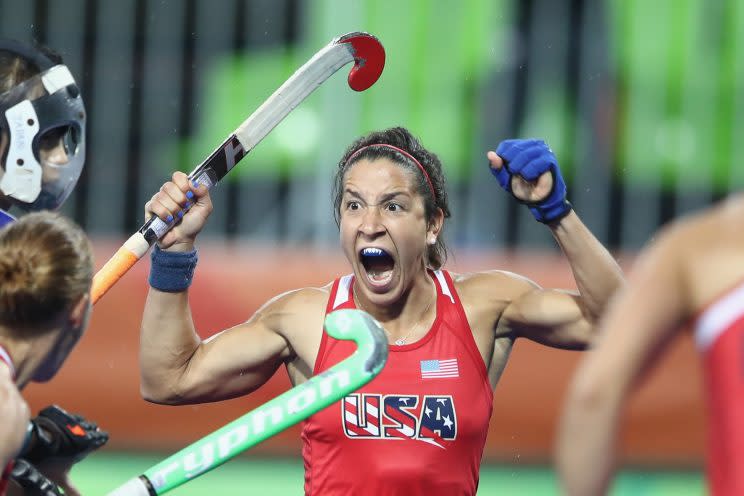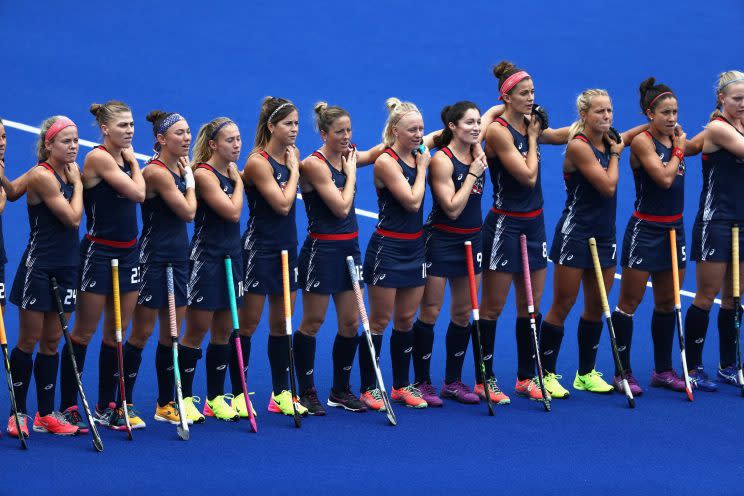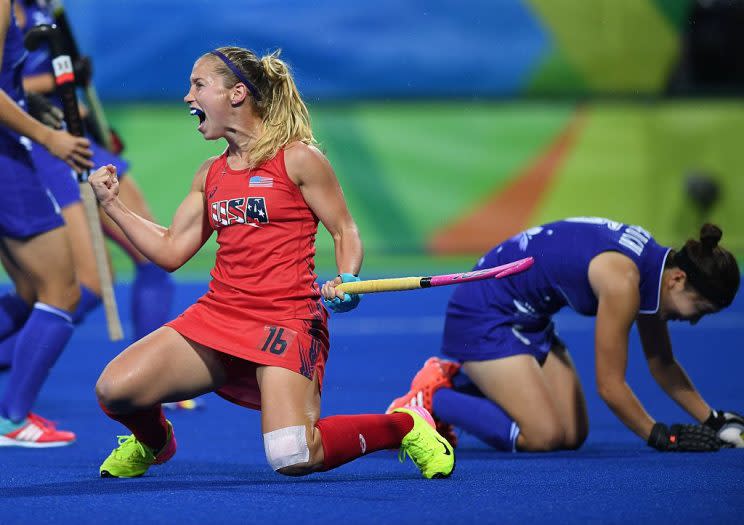Why USA Olympic field hockey suddenly isn’t terrible

Medal count | Olympic schedule | Olympic news
RIO DE JANEIRO – Field hockey has always been a puzzling blind spot for Team USA in the Summer Olympics.
As of 2015, there were over 60,500 high-school field-hockey players in the U.S., according to the National Federation of High Schools. While that puts it in the lower tier of participatory sports, and its numbers are in slight decline, it’s a substantial amount of athletes for a sport with scholarship opportunities.
Yet Team USA has been a non-factor for the better part of last 30 years in Olympic women’s field hockey.
[Related: U.S. field hockey upsets No. 2 Argentina in Olympic opener]
After taking bronze in 1984, their first Olympic appearance, the team hasn’t medaled since in the Games it qualified for – Team USA missed the cut in 1992, 2000 and 2004. Their best finish was fifth in Atlanta 1996, but the rest of their appearances have resulted in two eighth-place finishes (Seoul 1988, Beijing 2008) and one of the program’s lowest moments: Last place in the London 2012 tournament.
“Coming in last place in [London] was heartbreaking,” said Team USA national team forward Katie Bam. “We’ve had some experiences that we didn’t necessarily enjoy.”
In World Cup competition, outside of a third place finish in 1994 and a sixth place finish in 2006, the Americans hadn’t placed better than eighth from 1983 until 2014.
Something had to change.
Well, everything had to change.
After the London Olympics flameout, Lee Bodimeade, the team’s coach since 2005, and technical director for high performance Terry Walsh were both let go. Craig Parnham, an assistant with Great Britain’s women’s national team, was hired as head coach. USA Field Hockey also hired a sports psychologist to evaluate the entire program.
“The result from the last Olympics was a difficult moment for the team. They were detached when I arrived, physically and emotionally. We weren’t together as a group. We weren’t training together. We needed to establish some consistency in training as a group, as a program. That was a big part of it,” said Parnham.
[Related: The U.S. could win its 1,000th Summer Olympic gold medal Saturday]
The most dramatic change was geographic. The team used to train in Chula Vista, California. But they shifted operations to Lancaster County, Pennsylvania, in 2013, closer to where the majority of the national team players live. Fifteen players on the national team are either from Pennsylvania or New Jersey.
“One of the big findings [in our studies] was that players felt being so far away from their support network was detrimental to performance. Most of our sport is centered in the Northeast, of course, and while the Olympic Training Center in California was great, there was that great distance gap,” said Simon Hoskins, Team USA’s executive director, via Philly.com.
After the move East was complete, Parnham and the players got to work.
“The first thing we did when we started this journey was establish what we wanted to get done, and how we wanted to do it. The players drove the standards. They drove the direction. And that’s what you do as a coach: When players have power of ownership, that’s when I find success can happen. That guides the train,” he said.
“USA has always had great heart, great drive. They never give in. When I worked with other teams I always cited that.”

Slowly, the culture of the team began to change, and with it, the results. Fourth in the 2014 World Cup. Winners of the 2015 Pan-American Games. Internationally ranked in the top 10 as they entered the Rio Olympics tournament.
“No magic dust,” said defender Rachel Dawson. “It’s not anything super significant, like one major thing. We rebuilt our culture four years ago and that’s been the major thing. It’s manifesting on the field.”
What changed? “How we train every single day,” she said. “The build-up. How we prepare. We’ve been willing to have the tough conversations and the introspection to look at who we are.”
This is who USA Field Hockey is, entering their final game of pool play on Saturday against Team GB: Undefeated.
They beat Argentina, a massive power in field hockey, 2-1. They repeated that score against another powerhouse, Australia.
“Numbers would say it’s an upset. But we know if we play the level we know we can play at, we can compete with anyone,” said goalie Jackie Briggs.
Then they took care of business against a team they were favored against, Japan, 6-1.
“It’s easy to step up and play the teams that are ranked higher than you. It’s hard to step up and bury teams that are ranked lower than you. So this is a statement game. This shows us out professionalism right here,” said forward Katie Bam.
Suddenly, the last-place team in London 2012 — which has 10 players in the 2016 squad, including Lauren Crandall, Katie Reinprecht, Julia Reinprecht, Dawson and Bam — has designs on a medal in Rio.
“We’ve come in with a new culture, mindset to this team. We’ve put in the work. We’ve had some awful days and we’ve had some great days leading up to this. That work we’ve been putting in for the last four years has been for this moment,” said Bam.

This moment is much more than just the drive for a medal for the U.S. It’s a moment to firm up the future of the sport, both back home and in the Summer Games.
Field hockey was one of the sports on the chopping block in the IOC’s 2013 evaluation of the events. “This Olympics, we were in jeopardy of not being here. Not as a team, but as a sport. So getting all the recognition we can, the better we do, the more we get noticed, the better it is for our sport,” said Bam.
Keeping field hockey on the biggest stage is essential for its growth in the U.S., said the players.
“Like any sport, it’s the infrastructure. You think of an NBA team. Young kids watch the NBA so much. And there’s not a visual representation of field hockey for little kids. With the Internet and the availability of the game, we’re getting better. They’re starting the game younger, and seeing it played at a higher level,” said Dawson.
Parnham agreed.
“The shop window [for the sport] is the women’s national team. And any young player that aspires to play at any higher level can be inspired by these ladies,” he said. “It’s important for our program that we do well. It’s important for the future of the sport in America. We want to hook more players on the game.”
Finally becoming a medal contender again is an enormous step in that direction.
—
Greg Wyshynski is a writer for Yahoo Sports. Contact him at puckdaddyblog@yahoo.com or find him on Twitter. His book, TAKE YOUR EYE OFF THE PUCK, is available on Amazon and wherever books are sold.
Listen to Yahoo Sports’ Greg Wyshynski podcast from Rio on GRANDSTANDING, featuring U.S. swimming legend Summer Sanders on Michael Phelps, IOC doping and Donald Trump:

 Yahoo Sports
Yahoo Sports 

